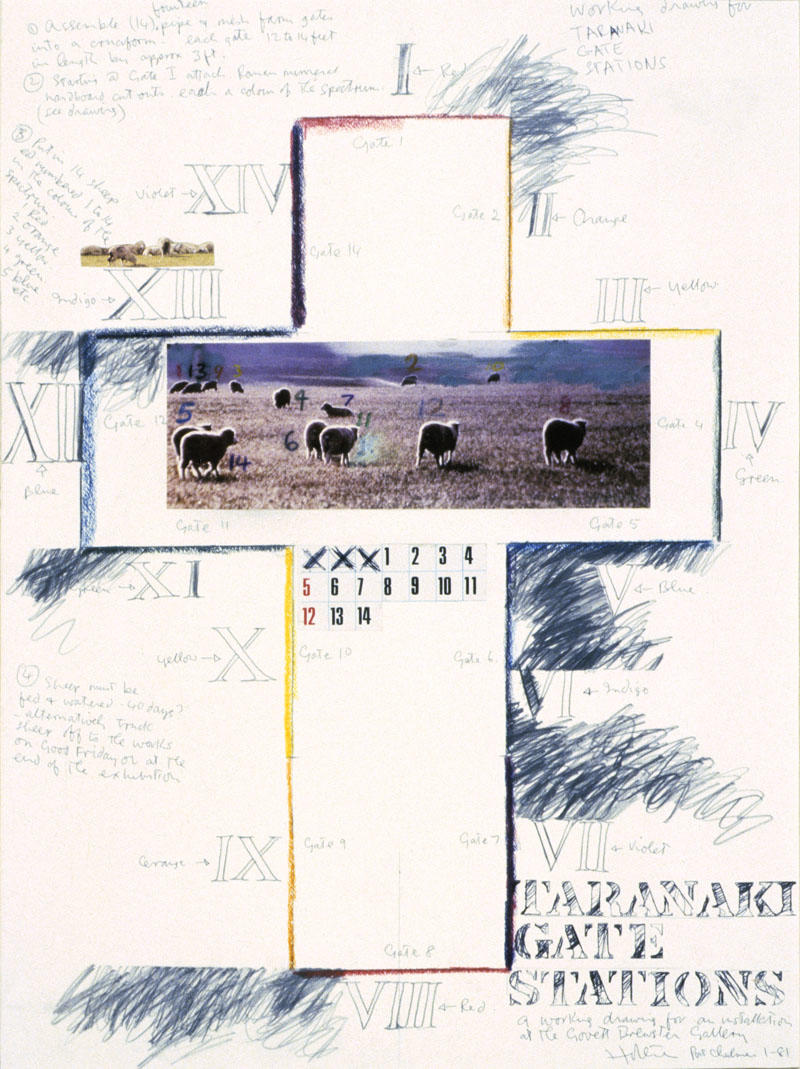Anything Could Happen, ex. cat., Sculpture on the Gulf, Auckland, 2024.
_
.
It’s been called ‘one of the strangest pieces of religious art imagined in this country’. For the Easter 1981 show Stations of the Cross: An Exhibition Based on the Passion of Christ at Ngāmotu/New Plymouth’s Govett-Brewster Art Gallery, Ralph Hotere made a modest proposal.
For his work Taranaki Gate Stations, Hotere asked the Gallery to construct a crucifix-shaped pen using fourteen standard pipe-and-mesh farm-fence units, to place fourteen sheep in it, and to feed and water them for forty days. ‘Alternatively truck sheep off to the works on Good Friday or at the end of the exhibition’, he suggested. The gates were to be marked with Roman numerals (I–XIV) and the sheep painted with Arabic ones (1–14), both in a spectrum of fourteen colours.
The gallery didn’t realise the proposal, but included Hotere’s two collage drawings outlining it in the show and acquired them for its collection. In its audacity, Hotere’s idea stood in stark contrast to the other works in the show, which were more conventional paintings and sculptures, more standard depictions of the subject.
Hotere’s proposal still seems surprising and cheeky, and out of step with his place in the art-history books, the art market, and the popular imagination. It belongs less to the New Zealand painting mainstream, with which he is identified, more to post-object art. It’s the kind of work that might have been made by a Jim Allen or a Bruce Barber, for Auckland City Art Gallery’s Project Programme, a Mildura Sculpture Triennial, or an ANZART. It looks forward ten years to Hotere’s collaborative installations with Bill Culbert (begun in 1991) and his No. 8 installations (1992), made with New Zealand’s favourite fencing wire—neither of which seem anywhere near as edgy.
How should we read the work?
Hotere was Catholic, but the idea seems less religious and redemptive, more realistic and pessimistic.
Is it a nod to Parihaka in Taranaki, whose passive resisters erected their fences as fast as the colonial government pulled them down? In 1881, one hundred years earlier, the village was invaded, and many of its people were rounded up and imprisoned.
Is it a riff on the work of Hotere’s friend Colin McCahon, who engaged with the Stations of the Cross theme extensively in the 1960s and 1970s? (Hotere owned McCahon’s 1974 Stations canvas Walk with Me 1.) Does Hotere take McCahon’s ‘gate’ metaphor literally?
Perhaps Taranaki Gate Stations was an expression of Hotere’s own desire not to be fenced in, typecast artistically.
Interestingly, in a subsequent third collage drawing for a ‘second version’ of the idea, Hotere stirs in topical references to the Springbok Tour. The Stations show ran from 11 March to 20 April 1981; the Springbok Tour occurred in July, August, and September. As it is dated simply 1981, we can’t know if this third collage drawing was produced in anticipation of the Tour or in full knowledge of the divisive protests it prompted. It makes no reference to the protests as such.
This third drawing incorporates a photo, attributed to the Otago Daily Times, showing rugby players playing in a field alongside a similar number of sheep, with Hotere’s crucifix pen sketched in around them. An annotation proposes a ‘happening’, requiring the sheep to be decanted and the pen used for a seven-a-side game between the All Blacks and Springboks—a cage fight: ‘ALL BLACKS V SPRINGBOKS 14 players (a seven a side happening) players enclosed in 14 steel meshed gates—OR BARBED WIRE no spectators—a safety precaution (sheep, if well behaved, might be allowed to view the game)’.
Nothing quite computes. Is Hotere making an analogy between the gentle folk at Parikaha (building their righteous fences) and black South Africans forcibly cooped up in their bantustans (behind bad ones)? If so, why would he have All Blacks and Springboks compete together within this pen?
Perhaps Hotere wilfully mixes his metaphor, offering a puzzle without a solution, just to make us think. Even the reference to ‘Taranaki gates’ is wobbly. The term refers to cheap, crude, DIY-style wire-and-post gates, not the more expensive mesh-and pipe fence/gate units stipulated in the first two collage drawings. However, the third drawing says a wire-and-post version could be an alternative, and even includes a marginal illustration of a unit—with barbed wire.
Did Hotere intend for the work to be made or was the proposal just a provocation, a joke? It certainly reads like a conceptual-art ‘instruction’ piece that the gallery could realise on the artist’s behalf. The specifications are practical and precise, with materials and measurements. But, even if the instructions are clear, they are incomplete. They don’t say if the work is to be installed inside the Gallery (it wouldn’t fit) or outside (possible, but where?).
With the kind permission of the Hotere Foundation Trust, we’re finally realising Taranaki Gate Stations—or our idea of it—forty-three years later, after apartheid ended in 1994 and after the Parihaka apology of 2017. We’re presenting it out of curiosity, to add a historical dimension to the show and to surprise audiences. While we have followed Hotere’s instructions to the letter, we are aware that we are realising his work in a different place and time, and in different company. It can only ever be after Hotere, our imagining what he imagined.
